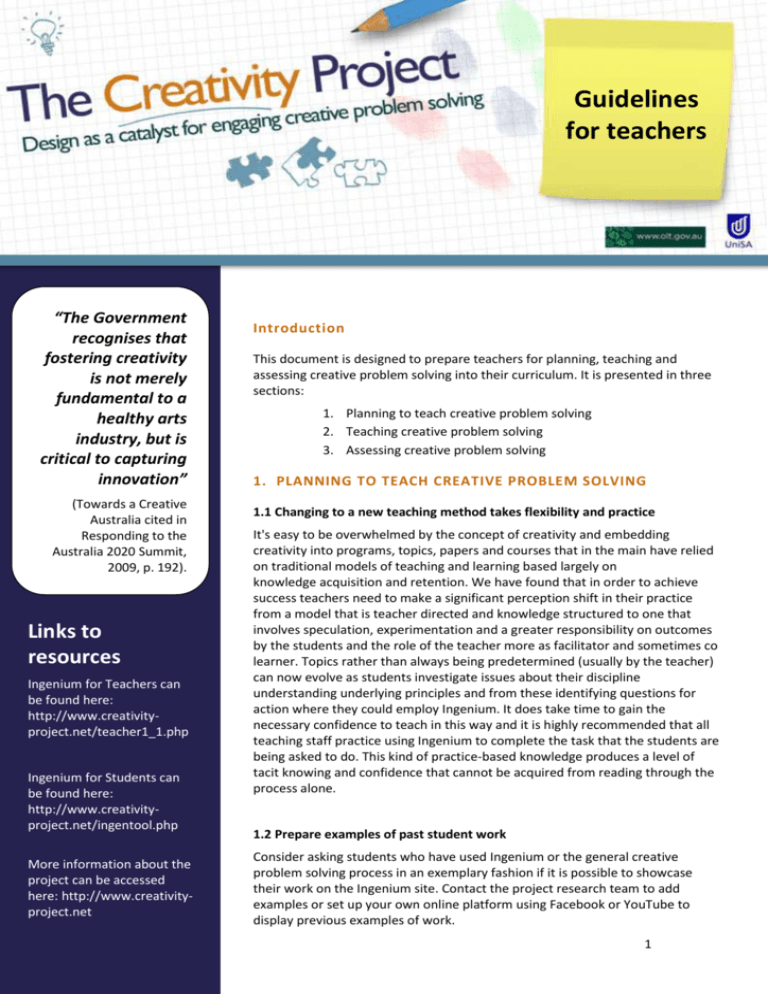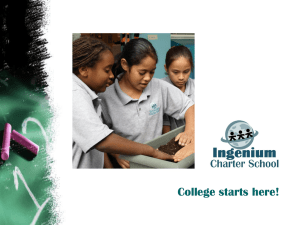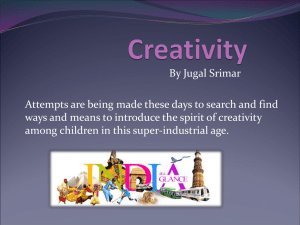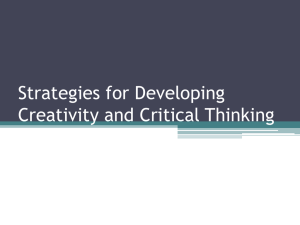Word - Design as a catalyst for creative problem solving
advertisement

Guidelines for teachers “The Government recognises that fostering creativity is not merely fundamental to a healthy arts industry, but is critical to capturing innovation” (Towards a Creative Australia cited in Responding to the Australia 2020 Summit, 2009, p. 192). Links to resources Ingenium for Teachers can be found here: http://www.creativityproject.net/teacher1_1.php Ingenium for Students can be found here: http://www.creativityproject.net/ingentool.php More information about the project can be accessed here: http://www.creativityproject.net Introduction This document is designed to prepare teachers for planning, teaching and assessing creative problem solving into their curriculum. It is presented in three sections: 1. Planning to teach creative problem solving 2. Teaching creative problem solving 3. Assessing creative problem solving 1. PLANNING TO TEACH CREATIVE PROBLEM SOLVING 1.1 Changing to a new teaching method takes flexibility and practice It's easy to be overwhelmed by the concept of creativity and embedding creativity into programs, topics, papers and courses that in the main have relied on traditional models of teaching and learning based largely on knowledge acquisition and retention. We have found that in order to achieve success teachers need to make a significant perception shift in their practice from a model that is teacher directed and knowledge structured to one that involves speculation, experimentation and a greater responsibility on outcomes by the students and the role of the teacher more as facilitator and sometimes co learner. Topics rather than always being predetermined (usually by the teacher) can now evolve as students investigate issues about their discipline understanding underlying principles and from these identifying questions for action where they could employ Ingenium. It does take time to gain the necessary confidence to teach in this way and it is highly recommended that all teaching staff practice using Ingenium to complete the task that the students are being asked to do. This kind of practice-based knowledge produces a level of tacit knowing and confidence that cannot be acquired from reading through the process alone. 1.2 Prepare examples of past student work Consider asking students who have used Ingenium or the general creative problem solving process in an exemplary fashion if it is possible to showcase their work on the Ingenium site. Contact the project research team to add examples or set up your own online platform using Facebook or YouTube to display previous examples of work. 1 2. TEACHING CREATIVE PROBLEM SOLVING 2.1 Teaching the value of creativity Some students have difficulty understanding why creativity is an important graduate attribute that they will need to develop skills in. Giving practical examples of creativity in the profession/discipline can help in engaging students. Employer feedback as to the need for creative thinking in graduates will also interest students as will explaining which employability skills (specifically creativity) will be addressed in the course. For Health Sciences in particular, ask students to think of situations where creative thinking will be important in their future professional roles. This will help students broaden their thinking about the skills they will need in a professional capacity. Project Partners This collaborative project undertaken by the University of South Australia, the University of Adelaide, the Royal Melbourne Institute of Technology, James Cook University, the University of New England and Massey University . 2.2 A future-focused methodology There needs to be an understanding and emphasis on methodology from experiences where students deal in past scenarios to one that is dealing with possible future scenarios. The following should be questions that students need to consider when using Ingenium. Why are things the way they are? Why should they continue this way? How might they be different? The first two are to do with investigation, research, observation, analysis of things and the last is the application of this investigation into an outcome, an application and something new. There is not a lot of this 'new possibilities' in our teaching and learning. We mostly focus on what is already known and done. 2.3 ‘Little steps’ toward creativity Take 'little steps' in teaching creativity and don't try and do too much too soon. Our experience with Design and Technology and Home Economics students who were looking at the possibilities of introducing a creativity dimension into the existing curriculum dominated by materials and processes was to not try and tip the current practice on it's head but to build in a small beginning. This involved allowing students to identify a part of the process that they could change and how? One example involved students learning how to make cup cakes. The existing process would be retained but at the end of the exercise students could consider a context for the making of the cakes like designing an event around the product that could achieve a range of social interactions, fundraising for charity etc. In this way the broader experience of how food plays a part in our lives, socially, culturally and emotionally would be revealed. 2.4 Moving beyond instructional teaching Being creative and generating ideas is a lot harder to do than just following instructions and teaching creativity is a lot harder than giving set instruction. The end result is far more satisfying but it involves some risk taking on the part of both students and teachers. We have found that reluctance on the part of teachers to attempt the inclusion of creative approaches in their teaching has been due to a lack of confidence in their ability. This comes about due to a lack of understanding of what creativity is and we have found in our teaching that devoting time to explaining the nature of creative thinking, defining what it is before attempting activities creates understandings and confidence in subsequent tasks. 2.5 Valuing exploration and mistakes 2 2.8 Provide platforms for students to record their journey Creative problem solving is a step-by-step process and sometimes the journey taken by students is not evident in the product submitted for assessment. Provide a platform for students to record their creative problem solving journey in the form of a blog or paper-based journal. This journal should contain all of their thoughts, research and collaboration notes collected on their way to completing their assignment, including the Ingenium process. If maintained regularly a student’s journal will reveal an emergence of ideas that will show evidence of creativity. 2.9 Customising Ingenium to suit your curriculum If the vignettes provided for the student CPS framework do not relate to your discipline/profession, consider providing a worked example of a relevant problem to students. (If you can provide this to the research team, we will endeavor to have a video made of this problem solving to be available to students in future course offerings). 3. ASSESSING CREATIVE PROBLEM SOLVING 3.1 Self and peer assessment Allow students to self and peer assess in their learning process and in this way develop an understanding of what criteria is valued in the experience. Often in class we challenge the students to objectively determine how much they have learned from the task and not wait in anticipation for the teacher to make the determination. 3.2 Assess the process rather than the end product By assessing the student’s creative problem solving journey, recorded in either an on or offline journal, will reveal creative thinking that sometimes isn’t evident in the final assignment product. This can happen for various reasons, for instance if a student’s theoretical ability is more advanced than their practical skill some of the ideas that emerged from their problem solving process will not translate into their finished assignment. Recognising and rewarding creative problem solving, even if it isn’t evident in the final product helps to build the student’s confidence as a creative thinker. 3.3 Embed elements of Ingenium into assessment There is a tendency for students to skip through the creative problem solving process as quickly as possible. As a way of encouraging students to engage in the creative problem solving process ask students to provide elements of Ingenium (eg the mind map) into the assessment. 3





